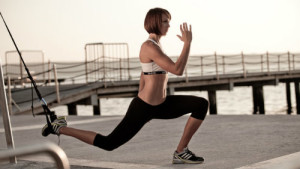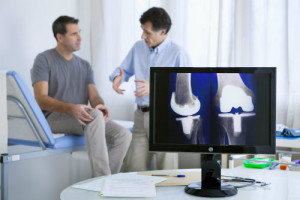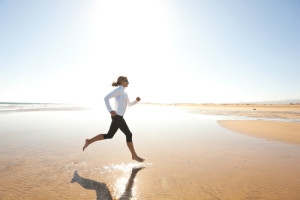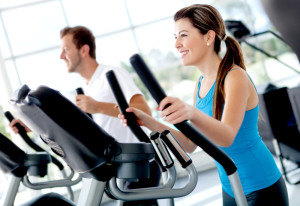Posts Tagged ‘allogenic’
How To Keep Your Hips Healthy
Posted in Injury Prevention | Sunday, November 15, 2015

Preventing Injuries
There are many steps you can take to keep your hips healthy and avoid injuries.
- Make time for warming up, stretching, and cooling down whenever you exercise.
- Exercise when you are well rested and when you’ve eaten enough to fuel your workout. Exercising when you are too hungry or exhausted can make it easier for you to make mistakes that lead to injuries.
- Get enough calcium and vitamin D in your diet. These nutrients are important in keeping your joints healthy.
- Cross train. Your exercise routine should be well rounded. Make time for cardio, weight lifting, and bodyweight exercises. Cross training allows you to give muscle groups a rest so that they don’t become fatigued. Cross training can also help you build strength and balance. Improving your strength and balance will help you avoid slips and falls that can lead to hip injuries.
- Maintain a healthy weight. Extra weight puts pressure on your joints and increases your risk for needing hip replacement surgery. The best way to keep the extra pounds off is to stay active and eat a balanced diet of whole grains, fruits, vegetables, and lean protien. Although it takes work, maintaining your weight is as simple as using all the calories you consume. If you are concerned about your weight, ask your doctor for help setting and reaching a healthy goal.
Treating Injuries
Hopefully you will be able to avoid hip injuries, but if you do injure your hip it essential to seek treatment as quickly as possible. The sooner an issue is treated, the better chance there is of minimizing the damage, correcting the problem, and preventing further injury. If you ignore an injured hip, the problem could become much worse.
Some injuries can be treated without surgery; other injuries require a minimally invasive procedure called hip arthroscopy. In extreme cases, hip replacement may be necessary. If you’d like to learn more about treatments for hip injuries, contact Dr. William Murrell.
An Introduction To Cartilage
Posted in Cartilage Regeneration | Friday, October 30, 2015

What is cartilage?
Cartilage is flexible connective tissue that contains no blood vessels or nerves. It is not as hard or rigid as bones but it is less flexible than muscles.
Cartilage plays a few different roles in the body—it helps your body bear and distribute weight, it provides a cushioning layer between bones, and it provides shape and structural support for the ears and nose
Where can it be found?
Cartilage is found in between bones where a bone meets another bone to form a joint. It can be found throughout the body around the ribs, between vertebrae in the spine, and at joints in the elbows, knees, and ankles. It can also be found in the bronchial tubes, ears, and nose.
How can you keep cartilage healthy?
Cartilage provides protection for your body, especially when you are moving, but because it doesn’t contain blood vessels, cartilage doesn’t heal itself as well as other parts of the body. If you want to keep moving it is important to do your best to protect the cartilage in your body.
There are a few things you can do avoid injuries to the cartilage in your body.
- Warm up before exercising—particularly before high impact exercises like running. This prepares your joints and may prevent torn cartilage.
- Seek treatment for injuries as quickly as possible so that they don’t escalate.
- Follow the instructions of your physical therapist and o the exercise that are assigned.
- Work to reach or maintain a healthy weight. Excess weight puts more strain on your joints and leaves you at risk for other serious health problems. The best way to maintain a healthy weight is to exercise regularly and eat a balanced diet with plenty of fruits and vegetables.
To learn more about protecting your bones, joints and cartilage, contact Dr. William Murrell and schedule an appointment.
Platelet Rich Plasma and The Healing Process
Posted in Platelet Rich Plasma Treatments | Thursday, October 15, 2015

Another way to improve the healing process is through platelet rich plasma. Here’s what you should know.
What is platelet rich plasma?
Platelet rich plasma (or PRP for short) is blood plasma with a high concentration of platelets. This substance includes growth factors that significantly improve the healing process. It is made from your own blood, so it is very safe and the creation process is quite simple.
How is platelet rich plasma created?
Platelet rich plasma is made from your own blood. First about 20cc of blood will be drawn from a vein. The blood will be placed in a centrifuge with a small amount of anti coagulant. The centrifuge spins the blood around and it separates into parts. The part with the high concentration of platelets is extracted and this is used when it is time to inject it into the patient. The extracted substance has a much higher concentration of platelets and growth factors, but it is still made from your body, so there aren’t concerns about allergic reactions.
How does it work?
Platelet rich plasma contains growth factors that help your body heal itself—it simply speeds up the process. In some cases it is used to help bones and tendons regenerate and in other cases it is used to help wounds close up and heal faster. It will be injected into the target area being treated and it will gradually work to help your body repair itself.
When is it used?
At Dr. Murrell’s office, platelet rich plasma treatments are used to help your body heal when operation isn’t necessary. For example, PRP treatments can be used to treat jumper’s knee. No surgery is performed, but an ultrasound-guided injection of PRP helps your knee begin to heal.
To learn more about how PRP is used, contact Dr. Murrell.
Tips For Preventing Ankle Injuries
Posted in Ankle Surgery | Wednesday, September 30, 2015

Fortunately many ankle injuries can be prevented—use these tips to get started.
Build strength: Stronger leg muscles will give you more control which in turn will help you avoid falls and slips that could result in ankle injuries. A few exercises that can help you build up leg strength include:
- Leg presses
- Lunges with dumbbells in each hand
- Squats with a barbell
- Seated leg curls and leg extensions
Improve balance and flexibility: Strength is an important part of having control, but balance and flexibility will also help you avoid twisting or spraining your ankles. Build flexibility by stretching before and after your workout and increase your balance by trying some of the following exercises:
- Workout with a partner—toss a medicine ball back and forth while standing on one leg.
- Stand on one leg without holding onto anything else. Stay on that leg for as long as you can and then switch to the other leg.
- Take a yoga class—Many yoga poses help you build strength, balance, and flexibility all at the same time. If you don’t want to go to a regular class, pick a few poses that require balance and add them to your stretching routine.
Choose your running path wisely: Running is a great way to stay in shape and improve your cardio fitness, but be careful where you run. Most people should avoid running on uneven surfaces because that makes it much easier to trip. If you want to run on hills, be sure to build up gradually and go slow when you are running downhill.
Build up to running on hills
Listen to your body: If you have pain in your ankle, stop what you are doing and adjust your exercise. Seek treatment for injuries before they become worse instead of ignoring the pain. An orthopedic specialist can help you heal from injuries and prevent problems in the future. To learn more about protecting your ankles and other joints, schedule an appointment with Dr. William D. Murrell Jr.
Choosing The Right Athletic Shoes
Posted in Sports Medicine | Tuesday, September 15, 2015

Get Advice From A Professional
Before buying a pair of athletic shoes get some expert advice. Schedule an appointment with a podiatrist or orthopedic surgeon, depending on your past issues and current health. Do you need to compensate for a previous injury? Do you have high arches? Do you put extra pressure on one part of your foot? Are your arches too flat? Do you roll your feet in when you run? Consulting the right expert ahead of time can help you know what to look for when you go shopping.
Remember That One Style Does Not Fit All
One common mistake people make is buying a generic pair of athletic shoes and using those shoes for all physical activities. You should choose specific shoes for specific physical activities. Your feet move differently when you are running than when you are hiking. When you are running, you might want more flexible, lightweight shoes. When you are hiking, stiffer, waterproof shoes may be more important. Relying on a generic pair of cross trainers could leave you vulnerable to injury. It will also mean your shoes wear out much faster.
Test Them Out
When you shop for shoes take some time to test them out.
- Go for a walk or a jog before trying the shoes on. Your feet will normally swell up a little when you are participating in athletic activities. Walking around before trying on the shoes will help you know how they will fit after you’ve been moving for awhile.
- Wear the same kind of socks that you’ll normally wear.
- Lace the shoes up completely so you know exactly how they will fit.
In many ways the right shoes are your foundation when you are participating in sports and other athletic activities. Wearing high quality shoes that fit well and are designed for specific activities will help you stay injury free and get the most out of your workout time.
Visit Dr. William D. Murrell Jr. to learn more about protecting your joints and preventing injuries while participating in sports.
How To Keep Your Energy Up During Endurance Events
Posted in Uncategorized | Sunday, August 30, 2015

Being too tired can lead to falls, incorrect posture, or other mistakes that lead to injury. Protect yourself against these injuries—use the following tips to maintain your energy during endurance sports.
Start With Enough Sleep
Exercising when you are sleep deprived is dangerous and less productive. Getting enough sleep is a foundation for staying energized throughout your workout. Most people need about 7-8 hours of sleep every night to be healthy. Use these tips to make getting enough sleep a little easier:
- Avoid drinking coffee within 6 hours of going to bed
- Avoid looking at screens an hour before bed—instead of unwinding by watching TV, read a book, take a bath, or listen to calm music.
- Exercising during the day will help you sleep better at night, but try to avoid exercising within 3 hours of going to bed.
Stay Hydrated
Dehydration quickly saps away your energy and mental focus. You don’t want to drink so much water that you have to frequently interrupt your workout or race for bathroom breaks, but you need to drink enough to keep your energy levels up.
Don’t force yourself to drink water when you don’t feel like it—instead, most experts suggest that you drink when you feel thirsty. Keep water or a sports drink accessible so that you can stay hydrated as needed. Listen to your body and ask your doctor if you need more guidance.
Give Your Body The Fuel It Needs
Carboyhydrates are key to providing your body with the energy it needs during an endurance event, but you’ll need more than simple sugars to keep yourself healthy and energetic. While simple sugars can give you an energy boost, they don’t provide much sustained energy. Eating a balanced diet with whole grains, lean protein, and fruits and vegetables will help you maintain your energy. A good example of a pre-race meal is a bowl of steel-cut oatmeal with almonds, a glass of milk, and a banana.
Maintaining your energy during endurance events is key to preventing injuries. To learn more about injury prevention and treatment, contact Dr. Murrell.




